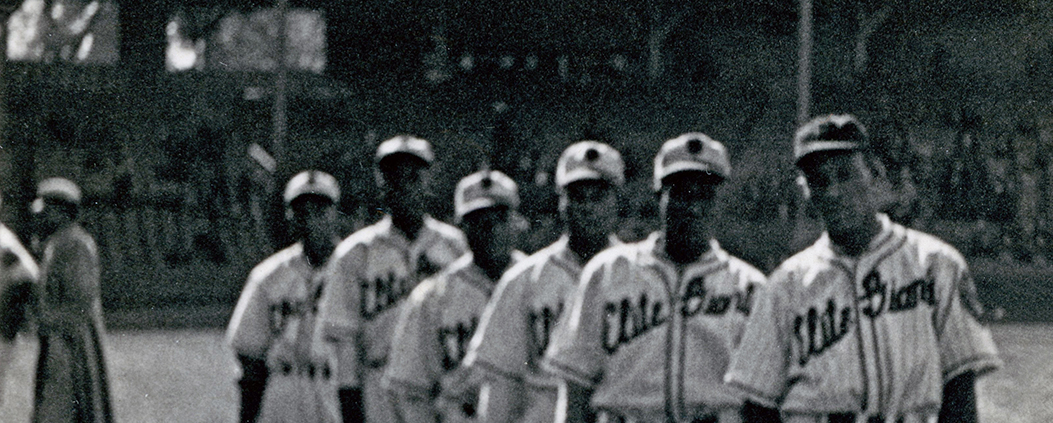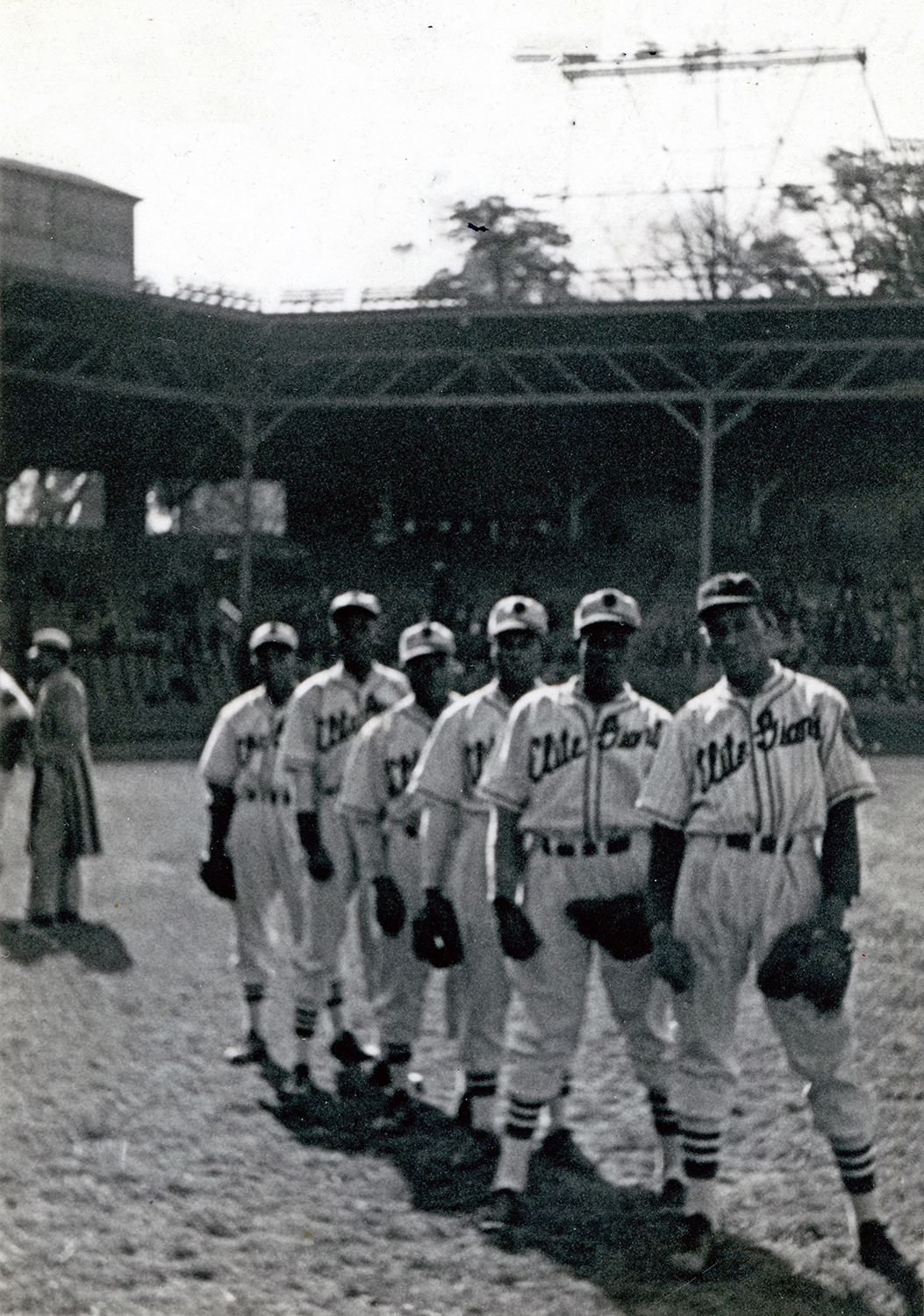September 16-24, 1939: Baltimore Elite Giants defeat Homestead Grays in five-game championship series
Baltimore Elite Giants pitchers at Oriole/Terrapin Park, 1940. Left to right: Emery Adams, Satchel Davis, Eddie Dixon, Woody Williams, Willie Hubert, and Bill Barnes. (Courtesy of David Stinson and Bernard McKenna)
The 1939 Negro National League Championship Series featured a matchup between the Homestead Grays, in pursuit of their third consecutive league championship, and the Baltimore Elite Giants. The Grays, led by their principal owner, future Hall of Fame member Cumberland Posey, and their player-manager, the veteran outfielder Vic Harris, finished atop the Negro National League for the third year in a row in 1939. The Elite Giants, owned by Tom Wilson and led by player-manager Felton Snow, finished fourth in the league, primarily on the basis of a strong second half of the season.
The powerhouse Homestead Grays featured three future Hall of Fame players: Ray Brown, who is in the Hall of Fame as a pitcher but who appeared in this series as an outfielder and first baseman; first baseman Buck Leonard; and catcher Josh Gibson. Leonard and Gibson were two of the most fearsome sluggers to ever grace a baseball diamond. In 1939 Gibson was 27 years old and Leonard was 31, and each was at the height of his ability. Other great players on the team included second baseman Sam Bankhead and pitcher Roy Partlow.
The Baltimore Elite Giants were also a talented team, with outfielders Bill Hoskins and Wild Bill Wright, and second baseman Sammy Hughes. They featured two future Hall of Famers, Biz Mackey, who did not appear in the Championship Series, and starting catcher Roy Campanella, who was only 17 years old. The matchup between Gibson and Campanella made this Series special in that it was a battle between two of the greatest catchers of all time.
Game One: September 16, 1939
Homestead Grays 2, Baltimore Elite Giants 1
44th and Parkside, Philadelphia
The best-of-five-games Championship Series began on the evening of Saturday, September 16, before approximately 3,000 spectators at the ballpark at 44th and Parkside in Philadelphia. The Homestead Grays played as the home team at this neutral location, selected to capitalize on the sizable Negro League fan base in Philadelphia. Bill Byrd got the start for the Elite Giants, facing lefty Roy Partlow of the Grays. In the bottom of the first inning, the Grays got off to a quick start when leadoff hitter David Whatley, Vic Harris, and Sam Bankhead singled, with singles, with Whatley scoring on Bankhead’s hit. Josh Gibson then came to the plate and grounded to Giants second baseman Sammy Hughes, who forced Bankhead out at second. Buck Leonard followed with runners on the corners and grounded the ball to shortstop Tommy “Pee Wee” Butts, who bobbled the ball long enough to allow Harris to score.
In the fourth inning, the Elite Giants tried to rally back. Sammy Hughes led off with a double to right field. He advanced to third on an out by Red Moore and scored when Bill Wright grounded out to third base. Although Byrd allowed 10 hits in the game, including doubles by Whatley, Bankhead, and Leonard, he kept the Grays from scoring after the first inning. Meanwhile Partlow was equally good, preventing any scoring aside from the Giants’ fourth-inning run. Both pitchers threw complete games, with Partlow getting the victory and the Grays taking a 1-0 lead in the series.1
|
Baltimore |
0 |
0 |
0 |
1 |
0 |
0 |
0 |
0 |
0 |
1 |
4 |
1 |
||
|
Homestead |
2 |
0 |
0 |
0 |
0 |
0 |
0 |
0 |
x |
2 |
10 |
1 |
Game Two: September 17, 1939
Baltimore Elite Giants 7, Homestead Grays 5
Oriole Park, Baltimore
The second game of the Series was played as the first game of a doubleheader on Sunday, September 17. The game was played in Baltimore at Oriole Park, previously known as Terrapin Park, one of the Elites Giants’ two home fields, along with Bugle Field. An estimated 3,000 fans were in attendance for the afternoon doubleheader. Tom Parker was the starter for Homestead, up against Jonas Gaines, southpaw hurler for the Elite Giants. Unlike the low-scoring first game of the Series, this game featured offensive explosions from both teams.
The Grays got on the board in the top of the first with a two-out rally. Sam Bankhead reached base on a single. Josh Gibson followed and pulled a home run over the left-field wall to give the Grays a two-run lead. The Grays continued to threaten as Buck Leonard ripped a single up the middle and Henry Spearman reached on a dropped third strike. Country Davis then drove a ball to deepest center field, but center fielder Henry Kimbro tracked it down with an impressive running catch to end the inning. The Elite Giants tallied their first run in the bottom of the second when Bill Wright drove a ball to left field for a double, and scored on a single by Felton Snow. In the top of the third, Kimbro made another athletic play in center field when he chased down a towering fly ball struck by Vic Harris.
In the top of the fourth, the Grays scored another run to extend their lead. Buck Leonard drew a leadoff walk, stole second, and scored on a two-out Texas Leaguer by Jelly Jackson. In the bottom of the frame, the Elite Giants had their biggest rally of the game. Red Moore walked to lead off the inning. Bill Wright’s double scored Moore, and Felton Snow followed with another double, plating Wright. Next up, Bill Hoskins singled to score Snow for the Elite Giants’ third run of the inning, giving Baltimore a 4-3 lead. The Grays answered back in the top of the fifth. Sam Bankhead singled, Josh Gibson walked, and Buck Leonard singled to drive in Bankhead and tie the game, 4-4. The Elite Giants were able to manufacture runs in the sixth and seventh innings. In the sixth, Felton Snow singled for his third hit of the game and took second on an error by Grays shortstop Jackson. Roy Campanella struck out, but Josh Gibson dropped the third strike and threw wildly to first, allowing Snow to score. In the seventh, Henry Kimbro singled, made his way to third on sacrifices by Hughes and Moore, and scored on a single by Wright. The score now stood 6-4 in favor of the Elite Giants.
In the top of the eighth, the Grays threatened once more. With one out, Henry Spearman singled. Country Davis followed with a single to center. Henry Kimbro fielded the ball and threw to third to try to cut down Spearman, who was attempting to take the extra base, but Kimbro’s throw flew over third baseman Snow’s head and into the Grays dugout, allowing Spearman to score and Davis to advance to third. The Elite Giants prevented more runs from scoring with two great defensive plays. First, Bill Wright made a strong throw from right field on Jelly Jackson’s fly out, keeping the runner at third. Then with two outs, Red Moore made a great play at first on a hard-hit groundball off the bat of Sam Bankhead. The Elite Giants now led 7-5.
The Grays refused to go down without a fight in the ninth. Ray Brown, pinch-hitting for David Whatley, singled to lead off the inning. But the Elite Giants defense came through once more, turning a third-to-second-to-first double play. Gaines then struck out Sam Bankhead to end the game and give the Elite Giants the victory.
The Elite Giants were able to win despite the Grays collecting 10 hits and 9 walks. Buck Leonard reached base all five times he came to the plate. The Elite Giants defense quelled several Grays rallies, and Baltimore tied the Series at one game apiece.2
|
Homestead |
2 |
0 |
0 |
1 |
1 |
0 |
0 |
1 |
0 |
5 |
10 |
4 |
||
|
Baltimore |
0 |
1 |
0 |
3 |
0 |
1 |
1 |
1 |
x |
7 |
10 |
1 |
Game Three: September 17, 1939
Baltimore Elite Giants 1, Homestead Grays 1
5 innings
Oriole Park, Baltimore
The second game of the doubleheader pitted the Elite Giants starter, lefty Tom Glover, against the starting hurler for the Grays, Edsall Walker. The Grays struck first, scoring a run in the top of the second inning. Country Davis led off the inning with a walk but was cut down at second on a groundball hit by Jelly Jackson. Jackson proceeded to steal second, go to third on Roy Campanella’s error, and score on another Campanella miscue, this time a passed ball. The Elite Giants scored in the bottom of the third. Campanella reached first on a muffed fly ball by Grays left fielder Vic Harris. Glover’s sacrifice advanced Campanella to second and brought up the top of the order. Henry Kimbro grounded out for the second out of the inning, but Sammy Hughes followed with a single to score Campanella and tie the game. Red Moore then drew a walk and Bill Wright was intentionally walked to load the bases. Grays pitcher Walker worked his way out of the jam by striking out Felton Snow.
The game remained a 1-1 tie as the 6:00 P.M. Sunday curfew approached. In the bottom of the fifth, the Elite Giants came within inches of winning the game. With one out, Sammy Hughes reached base on a walk. Red Moore struck out for the second out of the inning. Bill Wright followed and drove a ball to right field. Hughes raced around the bases attempting to score, but the Grays defense was solid, with Harris firing to cutoff man Bankhead, who threw a bullet to Gibson to cut down Hughes on a close play at the plate. The curfew ended the game, tied 1-1.3
|
Homestead |
0 |
1 |
0 |
0 |
0 |
1 |
3 |
1 |
||
|
Baltimore |
0 |
0 |
1 |
0 |
0 |
1 |
5 |
1 |
Game Four: September 23, 1939
Baltimore Elite Giants 10, Homestead Grays 5
44th and Parkside, Philadelphia
The Series resumed at 3:00 P.M. on Saturday, September 23, back in Philadelphia at the ballpark at 44th and Parkside. The Grays were the home team once again and gave the start to Specs Roberts in his adopted hometown of Philadelphia. Baltimore manager Snow gave Bill Byrd the start, his second of the series. The umpire behind the plate was Cool Turner and covering the bases was Phil Cockrell.
Baltimore got the scoring started in the top of the second inning. Bill Hoskins slugged a triple and was driven home on a single to left by Roy Campanella, who then scored on a double off the bat of Byrd. Homestead came back in the bottom of the inning when Josh Gibson smashed a leadoff home run over the center-field wall. The Grays tacked on another run in the bottom of the third, and two more in the fourth to extend their lead to 4-2.
The fifth inning was rather tempestuous and demonstrated the competitive fire of both teams. Elite Giants center fielder Henry Kimbro led off the top of the inning with a single. Sammy Hughes then grounded out to short for what seemed like a routine play. However, Kimbro broke for third on the play. Grays first baseman Buck Leonard fired the ball across the diamond to shortstop Jelly Jackson, who ended up on top of Kimbro as he slid into the base. Kimbro was called safe on the play but, taking exception to Jackson’s physical play, hopped up and threw punches at him. Jackson readily took part in the fisticuffs himself until the players were pulled apart. Both Kimbro and Jackson were ejected from the game, but the rhubarb seemed to bring new energy to the Elite Giants. Hoss Walker replaced Kimbro on third base and was driven home by Red Moore to bring the Elite Giants within one run. In the sixth inning, Roy Campanella cracked a solo home run to left field to tie the game, 4-4.
In the seventh, the Elite Giants broke the game open. Hughes led off with a single and was sacrificed to second by Moore. The Grays took the bat out of the hands of Elite Giants cleanup hitter Bill Wright with an intentional walk. Felton Snow followed with a smash to shortstop, where Sam Bankhead was playing in place of Jackson. Bankhead bobbled the ball, and the bases were loaded. Bill Hoskins followed with a single, driving in two runs. Pee Wee Butts singled, loading the bases again, and Campanella continued the barrage with a single to drive two more runs home. The Elite Giants scored their fifth run of the inning when pitcher Bill Byrd’s fly ball to right scored Butts from third. When the dust had settled for the inning, the Elite Giants were leading 9-4. Both teams scored a single run in the ninth inning and the Elite Giants walked away with a 10-5 victory.
Both pitchers gave up 15 hits in the game, but Elite Giants hurler Byrd was able to stay out of much trouble and earned the victory. Notably, both Josh Gibson and Roy Campanella homered and had four hits each. However, all of Gibson’s at-bats came with the bases empty, while Campanella’s hits drove in five runs in leading his team to victory. The victory gave the Elite Giants a two-games-to-one lead in the series.4
|
Baltimore |
0 |
2 |
0 |
0 |
1 |
1 |
5 |
0 |
1 |
10 |
15 |
1 |
||
|
Homestead |
0 |
1 |
1 |
2 |
0 |
0 |
0 |
0 |
1 |
5 |
15 |
1 |
Game Five: September 24, 1939
Baltimore Elite Giants 2, Homestead Grays 0
Yankee Stadium, New York
Yankee Stadium was the location of the next game in the Series, played in the afternoon on Sunday, September 24. This was the fourth game the Elite Giants and the third game the Grays played in Yankee Stadium in 1939. Yankee Stadium being the location of this game allowed the Black press additional opportunities to market the game, and in turn to draw a much larger crowd and make for a significant payday for the teams. A crowd of 8,000 to 15,000 (depending on the game account) attended. The game also gave the teams the opportunity to vie for the Ruppert Memorial Trophy, named after the recently deceased owner of the Yankees, Jacob Ruppert. Beginning in 1939, the trophy was given to the Negro National League team that won the most games at the Stadium that year. For 1939, the winner of this game would take home the trophy.5
Baltimore was the home team for the game and started Jonas Gaines, who had won Game Two. Homestead started its ace, Roy Partlow, the winner of Game One. Just before the start of the game Elite Giants second baseman Sammy Hughes passed out on the bench and was taken to Harlem Hospital. (He was able to return to the Stadium before the end of the game.) Felton Snow took Hughes’s position at second for the game and Hoss Walker took Snow’s regular spot at third.
The game was a tense affair. Gaines and Partlow were in control and the two teams remained in a scoreless tie through the first six innings. In the bottom of the seventh, the Elite Giants offense finally broke through. After Red Moore grounded out, Bill Wright doubled and advanced to third on an infield single by Hoskins. Tommy Butts bunted foul on strike three for the second out of the inning. Hoss Walker followed with a groundball to third. Walker was safe when Henry Spearman’s throw pulled Buck Leonard off first base. Wright scored on the play and Hoskins went to second. Roy Campanella drove a ball to right field for a single, knocking in Hoskins with the second run of the inning. Partlow struck out Gaines for the third out, but the damage had been done, courtesy of two unearned runs. The Grays threatened in the eighth. With one out, Gaines walked Vic Harris, but got Bankhead for the second out. However, Gaines then walked Josh Gibson and Buck Leonard to load the bases. Elite Giants manager Snow went to his bullpen and brought in Willie Hubert in relief of Gaines. Hubert was the only reliever to pitch in the entire Series. Henry Spearman was up next for the Grays and battled, fouling off three pitches, before he was induced into hitting an infield popup to end the inning. Hubert finished off the Grays in the ninth inning, securing the victory for the Elite Giants. The Baltimore Elite Giants won the series three games to one and were the champions of the Negro National League.6
|
Homestead |
0 |
0 |
0 |
0 |
0 |
0 |
0 |
0 |
0 |
0 |
3 |
1 |
||
|
Baltimore |
0 |
0 |
0 |
0 |
0 |
0 |
2 |
0 |
X |
2 |
7 |
1 |
Series Postscript
After the game, the entertainer Bill “Bojangles” Robinson presented the Ruppert Memorial Trophy to Elite Giants team owner Tom Wilson. Aside from Game Four, which the Elite Giants won 10-5, all the games were quite close, and the Grays played well. On offense, the Grays were led by their sluggers, with Josh Gibson slugging two home runs and sporting a slash line of .353/.476/.706 for the Series. Likewise, Buck Leonard had an impressive series slash line of .462/.588/.462. For the Elite Giants, Roy Campanella gave a glimpse of his future greatness, smacking the only home run of the Series for his team while leading them with six RBIs. Jonas Gaines led the Elite Giants pitchers with two wins and a 2.16 ERA in 16⅔ innings pitched. Felton Snow also received plaudits for his steady leadership in blending a team of young players and veterans to the Series win.7
The final game of the series was the first game of a doubleheader, taking advantage of the Yankee Stadium crowd. The second game of the twin bill was played between a team made up of a mix of players from the Elite Giants and the Grays against what was termed an “All-Star” team of White minor leaguers That game was ended in the seventh inning due to darkness with the game tied, 1-1.8 After the Series, several players from both teams joined separate barnstorming tours, with the Elite Giants heading South toward New Orleans, and the Grays pairing with the New York Black Yankees and heading for North Carolina.9
Sources
In addition to the sources cited in the Notes, the author consulted:
Clark, Dick, and Larry Lester, eds. The Negro Leagues Book (Cleveland: Society for American Baseball Research, 1994).
Riley, James A. The Biographical Encyclopedia of the Negro Baseball Leagues (New York: Carroll & Graf Publishers, Inc., 1994).
Unless otherwise noted, Seamheads.com was used for all Negro League player statistics.
Notes
1 “Grays, Elites Divide,” Chicago Defender, September 23, 1939: 8; “Homestead Grays, Elites Divide Pair,” Chicago Defender, September 23, 1939: 8; “Partlow Bests Byrd as Grays Win Opener, 2-1,” Baltimore Afro-American, September 23, 1939: 21. The game details described are drawn primarily from the game stories provided in the Baltimore Afro-American. Different sources, including game box scores, often provided fewer details.
2 “Grays, Elites Divide,” Chicago Defender, September 23, 1939: 8; “Elites, Grays Tied in National League Title Series,” Baltimore Afro-American, September 23, 1939: 19.
3 “Grays, Elites Divide”; “Elites, Grays Tied in National League Title Series.”
4 “Campanella in Star’s Role as Elites Score,” Baltimore Afro-American, September 30, 1939: 21. Neil Lanctot, Campy: The Two Lives of Roy Campanella (New York: Simon & Schuster, 2011), 58-60.
5 Jim Overmyer, “Black Baseball at Yankee Stadium: The House That Ruth Built and Satchel Furnished (With Fans),” Black Ball: A Negro Leagues Journal, Volume 7, 2014, 5-32. Going into this game, the Elite Giants had won three games in Yankee Stadium while the Grays had won two for the season. It was decided that the winner of this game would be awarded the Ruppert Memorial Trophy.
6 “Elite Giants Win National League Championship,” Baltimore Afro-American, September 30, 1939: 21; “Baltimore Whips Homestead Grays for Title,” Chicago Defender, September 30, 1939: 9; “Elites Drub Grays For Jacob Ruppert Trophy,” New Journal and Guide (Norfolk, Virginia), September 30, 1939: 17; Dan Burley, “Baltimore Elites Cop NNL Title, Beat Grays 2-0,” New York Amsterdam News, September 30, 1939: 14; “Elites Beat Grays for Title,” Pittsburgh Courier, September 30, 1939: 16.
7 Randy Dixon, “The Sport Bugle,” Pittsburgh Courier, October 7, 1939: 17.
8 “Baltimore Whips Homestead Grays for Title,” Chicago Defender, September 30, 1939: 9; “Elites Drub Grays For Jacob Ruppert Trophy.”
9 “Elite Stars to Play in Game,” Baltimore Afro-American, September 30, 1939: 20; “Grays, Yanks Barnstorm Through South,” Baltimore Afro-American, September 23, 1939: 20.
Additional Stats
Baltimore Elite Giants vs. Homestead Grays
Oriole Park
Baltimore, MD
44th and Parkside
Philadelphia, PA
Yankee Stadium
New York, NY
Box Scores + PBP:
Corrections? Additions?
If you can help us improve this game story, contact us.



